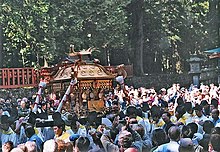Matsuri float
A Matsuri float, also known as a dashi or sansha, is a type of float that is either pulled or carried during a festival in Japan. It is a general term used to refer to any float that is used for this purpose.

Dashi are one of three large structures at Japanese festivals alongside Yatai, and Mikoshi.[1]
The terminology used for Matsuri floats can be inconsistent and varies by region in Japan. Some of the most common names used for these floats include Kasaboko, Danjiri, Yamahoko, Yamakasa, and Hikimono. Furthermore, Dashi and Yatai floats are sometimes called hikiyama and yama.[2]

Dashi floats (山車) are an important component of Japanese festivals, and were originally designed to look like mountains. This reflects the concept of Mountain worship, where people believed that spirits resided in the mountains. The spears and swords that adorn the tops of the dashi serve as markers for these divine spirits, and people ride on top of the dashi to help welcome the gods. Dashi have wheels and are pulled by people, and can carry passengers as well.[2]
Mikoshi is used to carry kami in a procession called Shinko-shiki. People carry the Mikoshi on their shoulders, while dashi is pulled by people. People are not allowed to ride on a mikoshi because it is only for gods.[2]
Dashi floats can be seen in many festivals in Japan, such as the Takayama Matsuri in Gifu Prefecture and the Kanda Matsuri in Tokyo. During the Takayama Matsuri, ten dashi floats go through the city in the day and at night. The Kanda Matsuri has both dashi floats and mikoshi, with people wearing traditional clothes walking through the streets.[2]
Gallery
change-
Hikiyama float at Aoba Festival
-
Umbrella floats clash at Tonami Night High Festival
-
Hikiyama and Children's Kabuki at Komatsu City Otabi Festival
-
Kakegawa type two-wheeled cart example
-
Three-wheeled Ishitori Festival's ritual wheel
-
Hamasaki Gion Yamakasa cart with six wheels
-
Yokkaichi Festival's "Oirimichi float" giant karakuri doll
-
Goten Yatai at Hamamatsu Festival
-
Danjiri competition at Imazu Hie Shrine Autumn Festival
-
Raku-car in Saijo City Ehime Prefecture
-
Floats for children's mikoshi at Imazu Hie Shrine summer festival
-
Hachioji Festival floats
-
Hanawa Bayashi Stall
-
Food Stalls at Banshu's Autumn Festival and Nada no Kenka Matsuri
-
Tokugawa-en Float Lineup
-
Owari Tsushima Tenno Festival loved by Oda Nobunaga and Toyotomi Hideyoshi
-
Kamezaki Tidal Basin Festival (Beach Hauling)
-
Borijo I carves floats for Otogawa Festival
-
13 carts gather in the Inuyama Festival to dedicate their karakuri to a shrine
-
Mitani Festival's "Underwater Procession"
-
Iida Toronoyama Festival's 16-meter-high, 5-ton float decorated with Toronoyama dolls
-
Segami Grand Festival in Echigo-Murakami City with Hamacho floats
-
Hitachi Furyumono Intangible Cultural Heritage of UNESCO
-
Odawara Matsubara Shrine's yellowtail portable shrine rush past the floats to the Otabisho
-
Shoho Maru float at Ubagami Grand Shrine procession festival in Esashi Town, Hokkaido
References
change- ↑ MATCHA. "Dashi And Yatai (Festival Floats) - Japanese Encyclopedia". MATCHA - JAPAN TRAVEL WEB MAGAZINE. Retrieved 2023-04-12.
- ↑ 2.0 2.1 2.2 2.3 MATCHA. "Dashi And Yatai (Festival Floats) - Japanese Encyclopedia". MATCHA - JAPAN TRAVEL WEB MAGAZINE. Retrieved 2023-04-12.MATCHA. "Dashi And Yatai (Festival Floats) - Japanese Encyclopedia". MATCHA - JAPAN TRAVEL WEB MAGAZINE. Retrieved 12 April 2023.
- "Hikiyama in Shinminato" (Shinminato, Toyama Board of education) published in October 1981.
- "Takaoka Mikurayama" (Takaoka City Board of Education) 2000, published on 31 March 2000.
Other websites
change- Yama, Hoko, Yatai, float festivals in Japan – UNESCO World Intangible Cultural Heritage "Yamaboko Yatai Event" Explanation and Video (English)